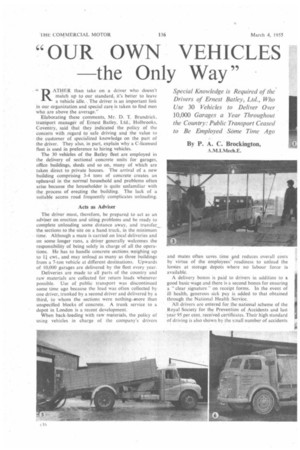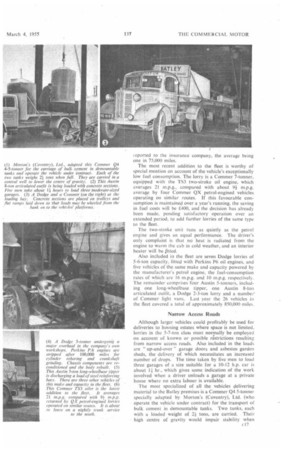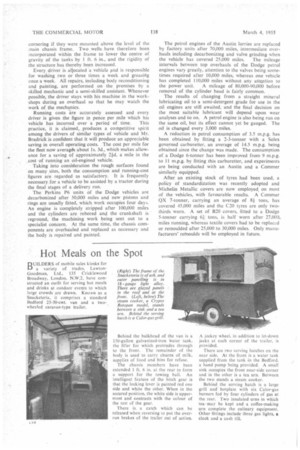"OUR OWN VEHICLES the Only Way"
Page 54

Page 55

Page 56

If you've noticed an error in this article please click here to report it so we can fix it.
Special Knowledge is Required of the Drivers of Ernest Batley, Ltd., Who Use 30 Vehicles to Deliver Over 10,000 Garages a Year Throughout the Country: Public Transport Ceased to Be Employed Some Time Ago
By P. A. C. Brockington,
" ATHER than take on a driver who doesn't match up to our standard, it's better to leave a vehicle idle. The driver is an important link in our organization and special care is taken to find men who are above the average."
Elaborating these comments, Mr. b. T. Brandrick, transport manager of Ernest Batley, Ltd., Holbrooks, Coventry, said that they indicated the policy of the concern with regard to safe driving and the value to the customer of specialized knowledge on the part of the driver. They also, in part, explain why a C-licensed fleet is used in preference to hiring vehicles.
The 30 vehicles of the Batley fleet are employed in the delivery of sectional concrete units for garages, office buildings, sheds and so on, many of which are taken direct to private houses. The arrival of a new building comprising 3-4 tons of concrete creates an upheaval in the normal household and problems often arise because the householder is quite unfamiliar with the process of erecting the building. The lack of a suitable access road frequently complicates unloading.
Acts as Adviser The driver must, therefore, be prepared to act as an adviser on erection and siting problems and be ready to complete unloading some distance away, and transfer_ the sections to the site on a hand truck. in the minimum time. Although a mate is carried on local deliveries and on some longer runs, a driver generally welcomes the responsibility of being solely in charge of all the operations. He has to handle concrete sections, weighing up to U cwt., and may unload as many as three buildings from a 7-ton vehicle at different destinations. Upwards of 10,000 garages are delivered by the fleet every year.
Deliveries are made to all parts of the country and raW materials are collected for return loads whenever possible. Use of public transport was discontinued some time ago because the load was often collected by one driver, trunked by a second driver and delivered by a third, to whom the sections were nothing_ -.more than unspecified blocks of concrete. A trunk service to a depot in London is a recent development.
When back-loading with raw materials, the policy of using vehicles in charge of the company's drivers and mates often saves time and reduces overall costs by virtue of the employees' readiness to unload the lorries at storage depots where no labour force is available.
A delivery bonus is paid to drivers in addition to a good basic wage and there is a second bonus for ensuring a "clear signature on receipt forms. In the event of ill health, generous sick pay is addedto that obtained through the National Health Service.
All-drivers are entered for the national scheme of the Royal Society for the Prevention of Accidents and last year 95 per cent.. received certificates. Their high standard of driving is also shown by the small number of accidents ported to the insurance company, the average being one in 75,000 miles.
The most recent addition to the fleet is worthy of special mention on account of the vehicle's exceptionally low fuel consumption. The lorry is a Commer 7-tonner, equipped with the TS3 two-stroke oil engine, which averages 21 m.p.g., compared with about 91 m.p.g. average by four Cornmer QX petrol-engined vehicles operating on sirnilar routes. If this favourable consumption is maintained over a year's running, the saving in fuel costs will be £400, and the decision has already been made, pending satisfactory operation over an extended period, to add further lorries of the same type to the fleet.
The two-stroke unit runs as quietly as the petrol engine and gives an equal performance. The driver's only complaint is that no heat is radiated from the engine to warm the cab in cold weather, and an interior heater will he ptted.
Also included in the fleet are seven Dodge lorries of 5-6-ton capacity, fitted with Perkins P6 oil engines, and five vehicles of the same make and capacity powered by the manufacturer's petrol engine, the fuel-consumption rates of which are 16 m.p.g. and 10 m.p.g. respectively. The remainder comprises four Austin 5-tonners, including one long-wheelbase tipper, one Austin 8-ton articulated outfit, a Dodge 2-3-ton lorry and a number' of Commer light vans. Last year the 26 vehicles in the fleet covered a total of approximately 850,000 miles.
Narrow Access Roads
Although larger vehicles could profitably be used for deliveries to housing estates where space is not limited, lorries in the 5-7-ton class must normally be employed on account of known or possible restrictions resulting from narrow access roads. Also included in the loads are " up-and-over " garage doors and asbestos garden sheds, the delivery of which necessitates an increased number or drops. The time taken by five men to load three garages of a size suitable for a 10-12 h.p. car is about 1.1 hr., which gives some indication of the work involved when a driver unloads a garage at a private house where no extra labour is available.
The most specialized of all the vehicles delivering material to the Batley premises is a Commer Q4 5-tonner specially adapted by Morton's (Coventry), Ltd. (who operate the vehicle under contract) for the transport of bulk cement in demountable tanks. Two tanks, each with a loaded weight of 2/ tons, are carried. , Their high centre of gravity would impair stability when cornering if they were mounted above the level of the main chassis frame. Two wells have therefore been incorporated within the frame to lower the centre of gravity of the tanks by 1 ft. 6 in., and the rigidity of the structure has thereby been increased.
Every driver is allocated a vehicle And is responsible for washing two or three times a week and greasing once a week. All repairs, including body reconditioning and painting, are performed on the premises by a skilled mechanic and a semi-skilled assistant. Whenever possible, the driver stays with his machine in the workshops during an overhaul so that he may watch the work of the mechanics.
Running costs -are accurately assessed and every driver is given the figure in pence per mile which his
vehicle has incurred over a period of time. This practice, it is claimed, produces a competitive spirit among the drivers of similar types of vehicle and Mr. Bradrick is confident that it will produce an appreciable saving in overall operating costs. The cost per mile for the fleet now averages about Is. 3d., which makes allowance for a saving of approximately 2id. a mile in the cost of running an oil-engined vehicle.
Taking into consideration the rough surfaces found OU many _sites, both the consumption and running-cost figures are regarded as satisfactory. It is frequently necessary for a vehicle to be assisted by a tractor during the final stages of a delivery run.
The Perkins P6 units of the Dodge vehicles are decarbonized after 50,000 miles and new pistons and rings are usually fitted, which work occupies four days. An engine is completely stripped after 100,000 miles and the cylinders are rebored and the crankshaft is reground, the machining work being sent out to a specialist concern. At the same time, the chassis components are overhauled and replaced as necessary and the body is repaired and painted. The petrol engines of the Austin lorries are replaced by factory units after 70,000 miles, intermediate over hauls including decarbonizing and valve grinding when the vehicle has covered 25,000 miles. The mileage intervals between top overhauls of the Dodge petrol engines vary greatly, attention to the valves being sometimes required after 10,000 miles, whereas one vehicle has completed 110,000 miles without any attention to the power unit. A mileage of 80,000-90,000 before removal of the cylinder head is fairly common.
The results of changing from a straight mineral lubricating oil to a semi-detergent grade for use in the oil engines are still awaited, and the final decision on the most suitable lubricant will depend upon wear analyses and so on. A petrol engine is also being run on the same oil, but its effect cannot yet be gauged. The oil is changed every 3,000 miles.
A reduction in petrol consumption of 3.5 m.p.g. has been obtained by fitting a 2-3-tonner with a Solex governed carburetter, an average of 14.5 m.p.g. being obtained since the change was made. The consumption of a Dodge 6-tonner has been improved from 9 m.p.g.
to 11 m.p.g. by fitting this carburetter, and experiments are being conducted with an Austin and a Commer similarly equipped.
After an existing stock of tyres had been used, a policy of standardization was recently adopted and Michelin Metallic covers arc now employed_ on most of the vehicles, with favourable results. A Commer QX 7-tanner, carrying an average of 8i tons, has covered 45,000 miles and the C20 tyres are only two thirds worn. A set of B20 covers, fitted to a Dodge 5-tonner carrying 61, tons, is half worn after 27,000. miles running, whereas textile covers had to be replacA or remoulded after 25,000 to 30,000 miles. Only manufacturers' remoulds will be employed in future.












































































































